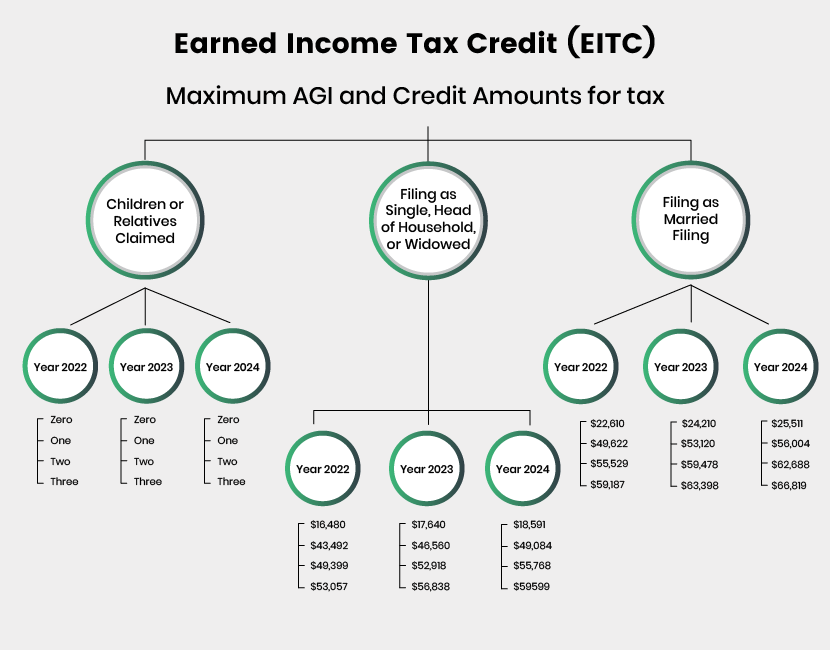- Overview of the Earned Income Tax Credit (EITC)
- For Individuals
- States and Local Governments with Earned Income Tax Credit (EITC)
- States without a State-Level EITC
- For Employers
- Benefits of the EITC
- Simplify Your Pay Stub Needs with SecurePayStubs
Overview of the Earned Income Tax Credit (EITC)
The Earned Income Tax Credit (EITC) is a valuable tax benefit for low to moderate-income individuals and families. It is designed to reduce tax liability and provide a refund if the credit exceeds the amount of tax owed.
For Individuals
Understanding the Federal EITC
The Federal EITC is available to eligible individuals who have earned income from employment or self-employment. It is structured to encourage work and reduce poverty by supplementing income wages.
Eligibility Criteria

To qualify for the Federal EITC, individuals must meet specific criteria:
1. Earned Incom: You must have earned income, which includes wages, salaries, tips, and self-employment earnings. Investment income must be under:
- $11,600 for tax year 2024
- $11,000 for tax year 2023
- $10,300 for tax year 2022
2. Filing Status: You must file as single, head of household, married filing jointly, or qualifying widow(er). Married individuals cannot file separately.
3. Income Limits: Income limits vary depending on filing status and the number of qualifying children.Your Adjusted Gross Income (AGI) must fall within specific thresholds to qualify.
Maximum AGI and Credit Amounts for tax Year 2024
| Children or Relatives Claimed | Filing as Single, Head of Household, or Widowed | Filing as Married Filing Jointly |
|---|---|---|
| Zero | $18,591 | $25,511 |
| One | $49,084 | $56,004 |
| Two | $55,768 | $62,688 |
| Three | $59,899 | $66,819 |
Maximum Credit Amounts for 2024
- No qualifying children: $632
- 1 qualifying child: $4,213
- 2 qualifying children: $6,960
- 3 or more qualifying children: $7,830
Maximum AGI and Credit Amounts for tax year 2023
| Children or Relatives Claimed | Filing as Single, Head of Household, or Widowed | Filing as Married Filing Jointly |
|---|---|---|
| Zero | $17,640 | $24,210 |
| One | $46,560 | $53,120 |
| Two | $52,918 | $59,478 |
| Three | $56,838 | $63,398 |
Maximum Credit Amounts for 2023
- No qualifying children: $600
- 1 qualifying child: $3,995
- 2 qualifying children: $6,604
- 3 or more qualifying children: $7,430
Maximum AGI and Credit Amounts for tax year 2022
| Children or Relatives Claimed | Filing as Single, Head of Household, or Widowed | Filing as Married Filing Jointly |
|---|---|---|
| Zero | $16,480 | $22,610 |
| One | $43,492 | $49,622 |
| Two | $49,399 | $55,529 |
| Three | $53,057 | $59,187 |
Maximum Credit Amounts for 2022
- No qualifying children: $560
- 1 qualifying child: $3,733
- 2 qualifying children: $6,164
- 3 or more qualifying children: $6,935
4. Qualifying Children: Children must meet relationship, residency, age, and joint return requirements. A child can only be claimed by one taxpayer for EITC purposes.
5. Social Security Number: You, your spouse (if filing jointly), and any qualifying children must have valid Social Security numbers.
6. U.S. Citizenship or Residency: You must be a U.S. citizen or resident alien for the entire tax year.
How to Claim the Earned income tax credit(EITC)
1. File a Federal Tax Return
- To claim the EITC, you must file a federal tax return, even if you are not required to file due to low income.
- Use Form 1040, U.S. Individual Income Tax Return, or Form 1040-SR, U.S. Tax Return for Seniors.
- If you have qualifying children, you must also complete and attach Schedule EIC (Form 1040 or 1040-SR), Earned Income Credit, to provide information about your children.
2. Ensure Accurate Documentation
- Double-check all forms for accuracy to avoid errors that could delay your refund.
- Ensure all Social Security Numbers are correct for you, your spouse, and any qualifying children.
3. Submit Required Forms
- Form 1040 or 1040-SR: Main tax return form.
- Schedule EIC: Required if you have qualifying children.
4. Avoid Common Errors
- Ensure all names and Social Security Numbers match SSA records.
- Report all earned income and ensure you meet the investment income limit.
- Include all required schedules and forms.
5. E-File for Faster Processing
- E-filing is the quickest and most accurate way to file your tax return.
- Use IRS Free File or fillable forms to e-file your return for free.
6. Choose Direct Deposit
- Opt for direct deposit to receive your refund faster.
- Make sure to provide accurate bank account information.
7. Track Your Refund
- Use the "Where's My Refund?" tool on the IRS website or the IRS2Go mobile app to check the status of your refund.
- Note that by law, the IRS cannot issue EITC and Additional Child Tax Credit (ACTC) refunds before mid-February. Most related refunds are available by March 1 if there are no other issues with the return.
8. Claim the EITC for Prior Years
- You can claim the EITC for the previous three years if you were eligible but didn't claim it.
- File Form 1040 and Schedule EIC for the applicable year.
- If you previously filed without claiming the EITC, file an amended return using Form 1040-X.
9. Get Assistance If Needed
- Volunteer Income Tax Assistance (VITA) Centers: Free help for eligible individuals.
- Tax Professionals: Consider hiring a tax professional if you need additional help.
- IRS Resources: Use the EITC Assistant tool on the IRS website to check eligibility and calculate your credit.
States and Local Governments with Earned Income Tax Credit (EITC)
The Earned Income Tax Credit (EITC) is a financial benefit provided by certain states and local governments in addition to the federal EITC. It offers a percentage of the federal credit amount to eligible low to moderate-income individuals and families. Refundability varies by jurisdiction, allowing qualifying taxpayers to receive a refund if the credit exceeds their tax liability.
| State or Local Government | Percentage of Federal Credit | Is Credit Refundable? |
|---|---|---|
| California | 45% | Yes |
| Colorado | 10% | Yes |
| Connecticut | 23% | Yes |
| Delaware | 20% | No |
| District of Columbia | 40% | Yes |
| Hawaii | 20% | No |
| Illinois | 18% | Yes |
| Indiana | 9% | Yes |
| Iowa | 15% | Yes |
| Kansas | 17% | Yes |
| Louisiana | 3.5% | Yes |
| Maine | 5% | Yes |
| Maryland | 50% | Yes |
| Massachusetts | 30% | Yes |
| Michigan | 6% | Yes |
| Minnesota | Ranges from 25% to 45% | Yes |
| Montana | 3% | Yes |
| Nebraska | 10% | Yes |
| New Jersey | 39% | Yes |
| New Mexico | 10% | Yes |
| New York | 30% | Yes |
| New York City | 5% | Yes |
| Ohio | 30% | No |
| Oklahoma | 5% | Yes |
| Oregon | 9% (12% if qualifying child under age 3) | Yes |
| Rhode Island | 15% | Yes |
| South Carolina | 41.67% | No |
| Vermont | 36% | Yes |
| Virginia | 20% | No |
| Wisconsin | One Child - 4%, Two Children - 11%, Three Children - 34% | Yes |
States without a State-Level EITC
Some states do not offer a state-level EITC, including Alabama, Alaska, Arkansas, Florida, Georgia, Idaho, Kentucky, Mississippi, Missouri, Nevada, New Hampshire, North Carolina, North Dakota, Pennsylvania, South Dakota, Tennessee, Texas, Utah, West Virginia, and Wyoming.
For Employers
Employer's Role in Supporting EITC
Employers play a crucial role in helping employees understand and access the EITC. By providing information, necessary documentation, and support, employers can contribute to their employees' financial well-being.
Promote Awareness
- Educate Employees: Include information about the EITC in employee communications, such as onboarding materials, payroll stuffers, or company newsletters.
- IRS Publications: Distribute IRS Publication 596 to employees, or provide access to the IRS EITC Assistant for eligibility checks.
Provide Necessary Documentation
- W-2 Forms: Ensure timely distribution of accurate W-2 forms to employees, which are essential for claiming the EITC.
- Income Verification: Be prepared to verify employment and income details if requested by employees or tax authorities.
Assistance and Resources
- Tax Preparation Support: Partner with local VITA programs or offer access to free or discounted tax preparation services for eligible employees.
- Payroll System Integration: Utilize payroll software that includes EITC eligibility notifications and reminders for employees.
Supportive Practices
- Employee Engagement: Encourage employees to participate in EITC education sessions or workshops to better understand eligibility and claiming procedures.
- Recognition Programs: Consider recognizing and celebrating employees who successfully claim the EITC as part of your commitment to employee financial health.
Benefits of the EITC
- Financial Relief: Provides significant financial relief by reducing tax liability and potentially providing a refund.
- Poverty Reduction: Lifts millions of working individuals and families out of poverty each year.
- Incentive to Work: Encourages workforce participation and rewards work through the tax code.
- Economic Stimulus: Stimulates local economies by putting money directly into the hands of low to moderate-income households.
Simplify Your Pay Stub Needs with SecurePayStubs
Unlock the power of accurate and reliable pay stubs with SecurePayStubs. Whether you're an employer or an individual, our tool is designed to simplify your pay stub generation process.
- Create Precise Pay Stubs: Generate detailed, accurate pay stubs effortlessly for any need.
- Ensure Compliance: Stay compliant with tax regulations and easily track earnings and deductions.
Ready to make pay stub creation hassle-free? Get Started with SecurePayStubs Today and experience the ultimate in pay stub accuracy and convenience!
This article has been updated from its original publication date of August 27, 2024.



